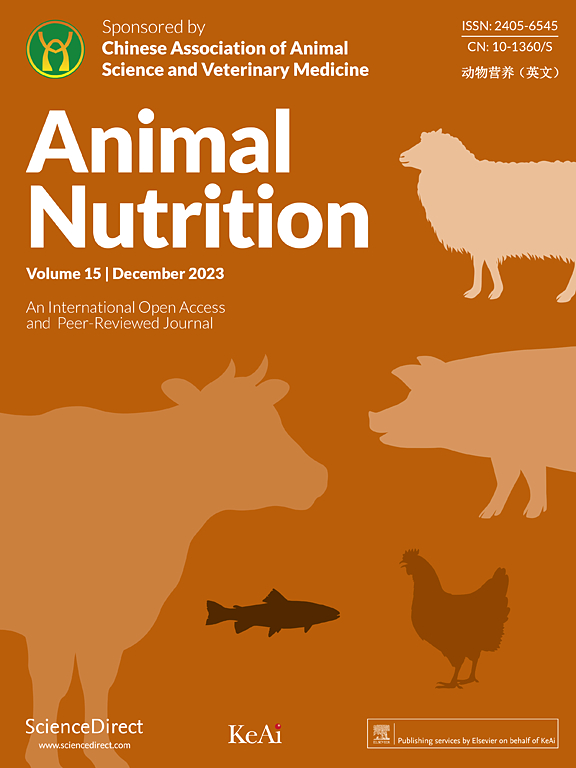乳腺炎发生和控制中的营养、胃肠道微生物和代谢物
IF 6.1
1区 农林科学
Q1 AGRICULTURE, DAIRY & ANIMAL SCIENCE
引用次数: 0
摘要
乳腺炎影响着包括人类和奶牛在内的几乎所有哺乳动物。在乳制品行业,牛乳腺炎是一种发病率居高不下的疾病,给奶牛的健康、乳制品的质量和奶牛场的经济造成严重损失。虽然外源性病原体侵入乳腺引起的乳房局部感染被认为是乳腺炎的主要原因,但已有证据表明,营养因素和胃肠道微生物组(GM)及其代谢产物也参与了乳腺炎症反应的发生,而且这种证据还在不断增加。营养不足,特别是能量负平衡 (NEB) 被认为是导致牛乳腺炎易感性增加的风险因素。有关营养和牛乳腺炎的数据大多涉及微量营养素。此外,转基因菌群失调可通过肠道-乳腺途径直接诱发或加重乳腺炎。乳房炎奶牛的乳汁和胃肠道(GIT)中都发现了有益的共生菌减少、细菌多样性降低、病原体和促炎代谢物增加。本综述讨论了营养(能量和微量营养素水平)与乳腺炎之间的关系,总结了转基因和代谢物在调节乳腺炎中的作用。同时,为预防和缓解乳腺炎提供了几种非抗生素策略,包括微量营养素、益生菌、短链脂肪酸(SCFA)、高纤维日粮、菊粉和芳基烃受体(AhR)。本文章由计算机程序翻译,如有差异,请以英文原文为准。
Nutrition, gastrointestinal microorganisms and metabolites in mastitis occurrence and control
Mastitis affects almost all mammals including humans and dairy cows. In the dairy industry, bovine mastitis is a disease with a persistently high incidence, causing serious losses to the health of cows, the quality of dairy products, and the economy of dairy farms. Although local udder infection caused by the invasion of exogenous pathogens into the mammary gland was considered the main cause of mastitis, evidence has been established and continues to grow, showing that nutrition factors and gastrointestinal microbiome (GM) as well as their metabolites are also involved in the development of mammary inflammatory response. Suboptimal nutrition is recognized as a risk factor for increased susceptibility to mastitis in cattle, in particular the negative energy balance (NEB). The majority of data regarding nutrition and bovine mastitis involves micronutrients. In addition, the dysbiotic GM can directly trigger or aggravate mastitis through entero-mammary gland pathway. The decreased beneficial commensal bacteria, lowered bacterial diversity, and increased pathogens as well as proinflammatory metabolites are found in both the milk and gastrointestinal tract (GIT) of mastitic dairy cows. This review discussed the relationship between the nutrition (energy and micronutrient levels) and mastitis, summarized the role of GM and metabolites in regulating mastitis. Meanwhile, several non-antibiotics strategies were provided for the prevention and alleviation of mastitis, including micronutrients, probiotics, short-chain fatty acids (SCFA), high-fiber diet, inulin, and aryl hydrocarbon receptor (AhR).
求助全文
通过发布文献求助,成功后即可免费获取论文全文。
去求助
来源期刊

Animal Nutrition
Agricultural and Biological Sciences-Animal Science and Zoology
CiteScore
7.40
自引率
3.20%
发文量
172
审稿时长
12 weeks
期刊介绍:
Animal Nutrition encompasses the full gamut of animal nutritional sciences and reviews including, but not limited to, fundamental aspects of animal nutrition such as nutritional requirements, metabolic studies, body composition, energetics, immunology, neuroscience, microbiology, genetics and molecular and cell biology related to nutrition, and more applied aspects of animal nutrition, such as raw material evaluation, feed additives, nutritive value of novel ingredients and feed safety.
 求助内容:
求助内容: 应助结果提醒方式:
应助结果提醒方式:


